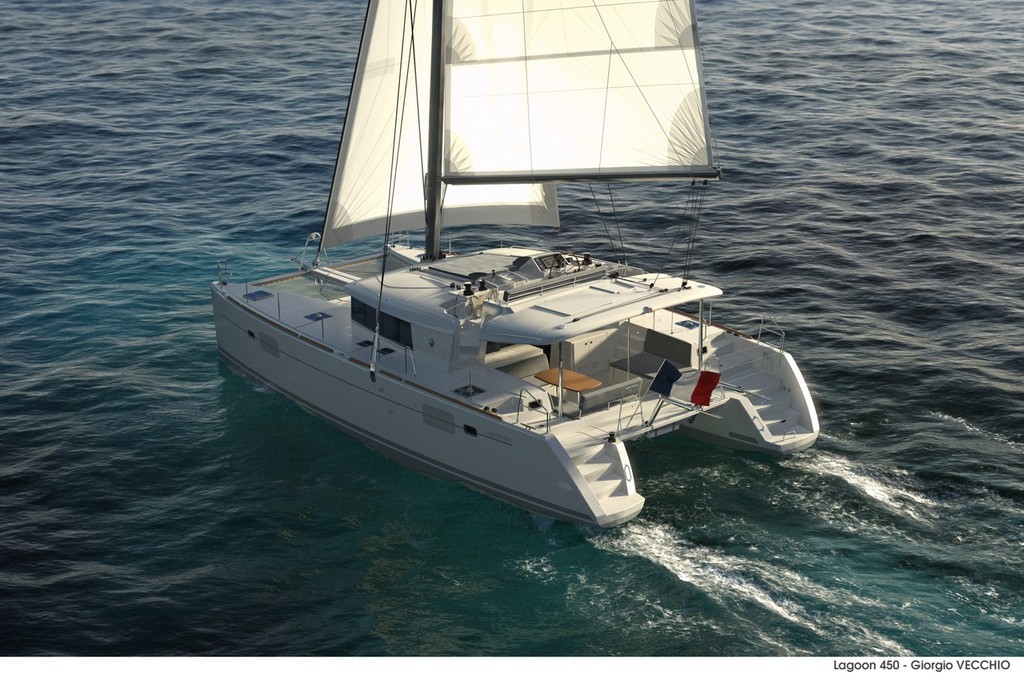'Cats are cool!' - Rally participants vote with their pockets
by Jeremy Wyatt, World Cruising Club on 10 Jun 2012

Lagoon 450 at sea - Lagoon is the most popular cat brand for World Cruising Club Rallies Simpson Marine
The World Cruising Club has been running sailing rallies for longer than many of their participants have been on the planet, so they know a thing or two about the trends in sailing. Jeremy Wyatt, long time director of the organisation, here writes about the surging world-wide popularity of catamarans:
Mainstream, normal, typical? However you describe it, the rapidly growing entries in World Cruising Club rallies prove it; sailing a catamaran offshore is no longer an unusual occurrence. Seventy catamarans crossed oceans with World Cruising Club during the last 3 seasons - transatlantic with the ARC, heading south with Caribbean 1500, or circumnavigating with World ARC.
American Steven Spracher was typical, sailing his 2005 Lagoon 380 S2 Southern Cross twice in the Caribbean 1500 rally from Hampton Virginia to Tortola BVI before heading off around the world. Southern Cross was one of 6 catamarans in the 60-strong 2011 US rally, and in the same year a record-breaking 29 catamarans set off from Gran Canaria to Saint Lucia with the ARC, an impressive 14% of the fleet .
Twice as Good?
We asked our catamaran sailors why they went down the twin-hulled route. The overwhelming response was for the comfort of living aboard a catamaran for long periods – the skippers citing: motion at anchor; interior layout and overall comfort aboard as their favourite aspects of catamaran sailing.
'As a live aboard you spend 80 to 90% of your time at anchor or in a marina, so living accommodation is most important. I have crossed the Atlantic, and done other long trips so sailing is not a problem, but comfort is most important for me', says Peter Ablett, owner of Lagoon 380 Salila, adding 'And laying on the trampoline at anchor in the Caribbean looking at the stars is unbeatable!'
'I have sailed both cats and monohulls over the Atlantic' says Norwegian skipper Trond Hansen, 'I could hardly believe the uplift in both comfort and ease of sailing in the cat’s advantage. No more heeling when cooking, showering or sleeping. It was interesting how much less tired the crew was onboard a cat.' Trond sailed in ARC 2010 with his wife and two children onboard Fountaine Pajot Orana 44 Occaisione.
Twice the Trouble?
Interestingly, half the respondents had owned monohulls before switching. So we asked them about the negatives of catamaran sailing, often cited by monohull sailors, such as the costs of moorings, looking after two engines, and stability.
Belgian Guy Libens has had his Lagoon 500 Kintukani for 3 years and says that after 20,000NM of ocean sailing, his initial concerns about the negatives of catamarans have been disproved. Peter Ablett is philosophical about mooring fees commenting: 'I have about 1.5 times the accommodation of a 38ft mono, and get charged 1.5 times in marinas.' Whilst other skippers in the group see two engines as a positive safety feature and not as a maintenance burden.
While most of the group hadn’t experienced severe weather in their catamarans, Australian Lagoon 560 Voahangy successfully ran under bare poles in winds of 50-55 knots, but owner Terry Steen adds 'In more wind than this I would consider deploying a drogue'. James Joll was able to actively sail Lagoon 421 Happy Cat in a Force 9 beam wind. (http://youtu.be/l2TwosgNLzg!Click_here for a great film of Happy Cat being overtaken by maxi-trimaran Banque Populaire at 25 knots in ARC 2011!)
Most owners admitted that upwind performance is compromised in a well-laden cruising catamaran, but were happy to accept this given that many blue water passages are predominantly downwind. We asked which downwind sail plans worked best. Half preferred a Parasailor, with slightly fewer preferring a standard spinnaker or a cruising chute. Twin headsails were mentioned as an alternative, and several respondents said they dropped the main altogether when sailing off the wind.
Try before you buy:
This is the advice from our owners. The motion at sea and at anchor, sailing performance and general boat handling are different from a monohull. Over 60% of the respondents had either chartered a catamaran or sailed with friends on a similar boat before making their purchase decision.
Only one of our experienced catamaran cruisers would not buy another catamaran – everyone else said a resounding yes. 'Absolutely!!' enthused Emmanuel Soultanakis of Catana 471 Delphini from ARC 2011.
World Cruising Club Catamaran Survey Statistics:
Average age of catamaran – 6 years
Average time in current ownership - 2.5 years
Half of owners had previously owned a monohull
Half of owners chose a catamaran as their first cruising boat
World Cruising Club Catamaran Statistics
ARC 2011: 29 catamarans and 1 trimaran
ARC 2010: 14 catamarans
ARC 2009: 17 catamarans
World ARC 2012-13: 5 catamarans
World ARC 2010-11: 5 catamarans
Caribbean 1500, 2011: 6 catamarans
Most popular ARC catamaran builders:
1st Lagoon, second Catana, third Fountaine Pajot
Did you like this article? If you are not a Sail-World subscriber already, did you know that you can keep up with all the news from the world of the cruising sailor with a weekly news hit? It's totally free, as all our income is from the advertisers.
Once you subscribe, all the non-racing news comes to you in one easy to read news magazine, right to your inbox. AND it's up to date, so you don't have to wait for the end of the month to find out what's going on. You can even subscribe a friend. http://www.sail-world.com/Cruising/international/newsletter_subscribe.cfm!Click_here_now!
If you want to link to this article then please use this URL: www.sail-world.com/98256